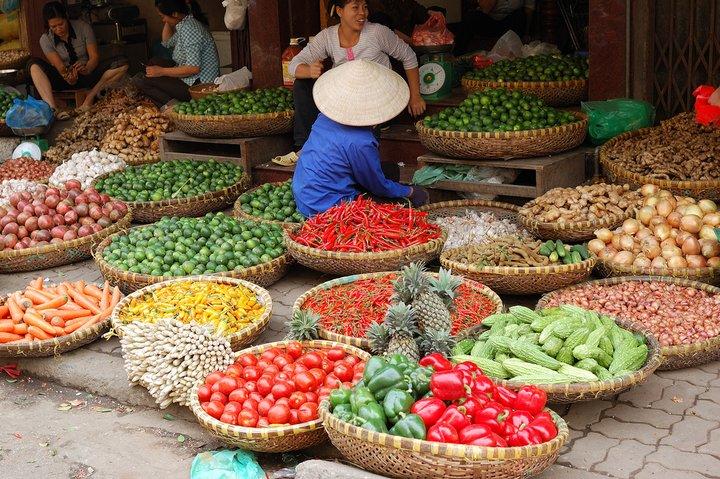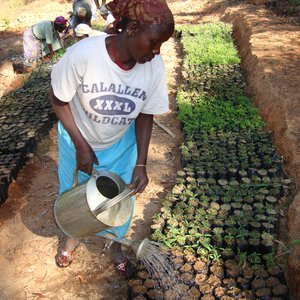Food and nutrition are moving to the city

Ann Tutwiler, Director General, Bioversity International, welcomes the 2017 Global Food Policy Report, published today by the International Food Policy Research Institute, and draws attention to the shift in the burden of malnutrition from rural areas to cities.
For too long, we have traded off calories for nutrition in our quest to end world hunger. While the numbers of people with caloric deficits is falling, the number with micronutrient deficiencies is stubbornly high – an estimated 2 billion people – and the number suffering from over-nutrition is rising distressingly fast.
The impact of these nutrition challenges on people’s quality of life and their productivity is devastating, and the impact on public sector budgets will continue to increase unless we find a way to achieve food security and improve nutrition. Sustainable Development Goal 2 — End hunger, achieve food security and improved nutrition, and promote sustainable agriculture — requires no less. That will be challenging enough.
In addition, for too long, most efforts by the agricultural development community to reduce hunger have only focused on rural areas. But already 50% of the world’s population lives in urban areas and by 2050, more than two-thirds of those people are going to be in cities. This poses a new set of challenges.
The Global Food Policy Report 2017, published today by the International Food Policy Research Institute (IFPRI), one of our CGIAR research partners, makes that clear.
James Garrett, Bioversity International Senior Research Fellow who contributed to the book, explains that one in three stunted children now lives in a city. That proportion is likely to increase. In addition, overweight and obesity are also concentrated in urban areas. As the report notes, the burden of malnutrition in all its forms is shifting from rural areas to cities, and so we need to ensure that our efforts now and in the future respond to this new reality.
 Bioversity International has a great deal of experience working in and around fast-growing cities. Our African Leafy Vegetables Initiative, for example, delivered three linked benefits for urban and rural residents alike. On the outskirts of Nairobi, Kenya, farmers learned to grow a constant supply of fresh, diverse, nutritious vegetables, boosting their own incomes and providing jobs for their neighbours. And, as a result of linking local farmers to local markets, city dwellers were able to find high quality, traditional crops in their local supermarkets, thus enriching their diets.
Bioversity International has a great deal of experience working in and around fast-growing cities. Our African Leafy Vegetables Initiative, for example, delivered three linked benefits for urban and rural residents alike. On the outskirts of Nairobi, Kenya, farmers learned to grow a constant supply of fresh, diverse, nutritious vegetables, boosting their own incomes and providing jobs for their neighbours. And, as a result of linking local farmers to local markets, city dwellers were able to find high quality, traditional crops in their local supermarkets, thus enriching their diets.
In Hanoi, Vietnam, Bioversity International is taking part in a new research project aiming to ensure that the city – capital of one of the most rapidly growing economies in the world – does not end up blighted by ‘food deserts’ for the urban poor. This is a real possibility, because the Hanoi city plan wants supermarkets rather than local fresh markets to be the main source of food for the city. In 2014 Hanoi had about 60 supermarkets; by 2025 the city planners want 1000. While on paper that may seem to be a good idea, the plan ignores the reality on the ground, particularly for the urban poor.
Poor people, who often work at multiple jobs, often do not have the time or means to travel to supermarkets, which may well not be close to where they live. And they almost certainly do not have the financial means to shop for a week’s supply of food at a time. These constraints mean poor people usually need to shop daily. In fact, our preliminary research in Hanoi suggests an additional obstacle I found especially surprising.
One reason poor people don’t go to supermarkets, even when they can, is that supermarkets are seen as places for the rich to shop. Our researcher Jessica Raneri, comments that at traditional markets it is perfectly acceptable to shop in casual clothes — even pyjamas are not an uncommon sight in the early morning before people start their work day. Whereas at the supermarkets, people tend to dress up to go shopping, which in turn can make the poor feel uncomfortable and out of place (Wertheim-Heck en Spaargaren, 2015**).
To address these challenges, Bioversity International and partners*, working together with six cities, have developed a transformational and innovative proposal that will consider how food is produced, including the diversity of crops; where it is produced, including alternative uses for the land and access to markets; and the ways in which the food that is produced and eaten affects human health and the environment.
Our work will provide the mayors of rapidly growing cities around the world, including the 133 cities signed up to the Milan Urban Food Policy Pact, with the tools and case studies that will help them to come up with plans and policies that feed the cities in sustainable ways, delivering high quality, safe and nutritious foods all year round to everyone, as well as offering all an equitable share of urban development.
Please take the time to read the Global Food Policy Report to explore how the global food system can best contribute to further reductions in hunger, malnutrition, and poverty while ensuring sustainable use of the world’s resources.
M. Ann Tutwiler
- Follow Ann Tutwiler on Twitter: @AnnTutwiler
- Read more blogs from Ann Tutwiler: DG Dialogues
- Find out more about Bioversity International’s research on Healthy Diets from Sustainable Food Systems
~~~
Further information:
This Research Program is part of the CGIAR Research Program on Agriculture for Nutrition and Health and is supported by CGIAR Fund Donors.
The official partners of this project are Fresh Studio, Bioversity International and Wageningen University. This project is funded by the University of South Carolina, within the Drivers of Food Choice Competitive Grant Program funded by the Bill and Melinda Gates Foundation and UK Aid – www.driversoffoodchoice.org
*This initiative to improve human and environmental health in peri-urban areas is carried out in partnership with Wageningen University, the Stockholm Resilience Center, EAT, Natural Capital Project, C40 , The Economics of Ecosystems and Biodiversity (TEEB).
**Wertheim-Heck, S.C.O. and Spaargaren, G. (2015) Shifting configurations of shopping practices and food safety dynamics in Hanoi, Vietnam: a historical analysis. Agriculture and Human Values, 33 (3), 655-671, DOI 10.1007/s10460-015-9645-4
Photo top: Market in Hanoi, Vietnam. Credit: Flickr/Rosino
Photo middle: Watering African leafy vegetable seedlings. Credit: Bioversity International/P. Maundu
